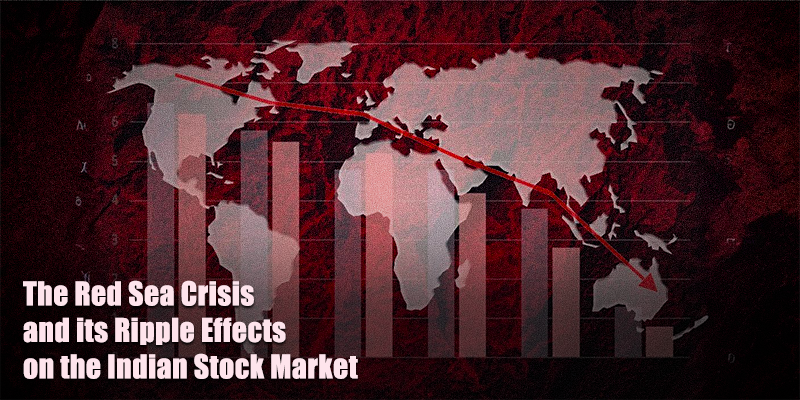Editor’s Note
Prof. Abhijit Biswas teaches Data Analytics at Globsyn Business School – which has always been considered to be one of the best MBA colleges in Kolkata placement wise. Prof. Biswas has 20+ years of diverse academic experience in Economics, Data Analytics, Business Intelligence, Econometric Modelling, Research & Development, consultation in Business Analytics, and Data Science, among others. He has completed exclusive certified courses in Data Analytics, Business Analytics, and R Programming from premium universities and corporate firms, globally. Prof. Biswas has served as a Senior Assistant Professor at leading engineering colleges and is also a member of the Royal Economic Society, UK. Additionally, he has been a Data Science and Talent Advisor at Neurologic AI and an Individual Consultant for the Asian Development Bank, as well as has multiple publications under his name on Scopus and UGC Care Journal.
The Red Sea, as an important maritime trade corridor, extends the Mediterranean Sea to the Arabian Sea through the Suez Canal, thus it aids in the movement of commodities and fuels. With geopolitical tensions rising alarmingly, the conflicts in this region are increasingly affecting countries such as India, who rely heavily on this corridor in terms of energy imports and exports.
In this blog, we will analyse the impact of the ongoing crisis on the Indian stock exchange and what investors need to pay attention for in this period of turbulence.
1. The Volatile Oil Prices and the Indian Economy
The Red Sea region is an important crossing for Middle East-to-Asia oil trade, volatility in this region makes the oil prices around the globe run amuck. Since India imports a significant amount of oil, sharp surges in oil prices are directly threatening the Indian economy.
Critical Sectors Impacted:
- Energy: Higher crude prices affect oil companies both on the cost side and margin side
- Aviation and Logistics: The price hike of fuel increases the cost of operation of any enterprise, thereby eating into profit margins
- Automobile: Increases the manufacturing and transport costs, with further possible ripple effects on automobile sales due to higher consumer prices
At Globsyn Business School, we encourage students to develop a multidisciplinary understanding of these trends by examining oil’s role in the economy and learning to analyse financial statements, market trends, and global news. This helps future professionals make informed investment decisions and anticipate sector-specific impacts.
2. Stress to Indian Rupee
The Red Sea crisis exerts further pressure on India’s current account deficit through costly imports of oil. This disequilibrium can further weaken the Indian rupee against the dollar, making imports costlier and hence inflating the prices. The case is even more severe for foreign investors, where a falling rupee further dilutes the value of their investments in India, often prompting them to retreat from Foreign Institutional Investments (FIIs). Seeing that FIIs are one of the significant props to the Indian stock market, any retrenchment in such flows would further inflate volatility in the market.
Implication on Stocks: An industry which imports heavily or has large foreign debt is going to feel the pinch of rupee devaluation more vigorously as the operational costs will rise and the re-payment of debts will happen costlier. This impact is felt much more in Pharma, Electronics, and Software industries, which export extensively.
At Globsyn Business School, our curriculum covers the effects of currency fluctuations and the role of FIIs in emerging markets like India. Through real-world case studies and simulation exercises, students learn strategies to hedge against currency risks and manage portfolios effectively in a volatile market environment.
3. Supply Chain Disruptions and Inflationary Pressures
The Red Sea route is indeed an important passage through which commodities and manufactured goods are traded from the Middle East, Europe, and Africa to Asian destinations. With such a scenario of tensions in the region, shipments may likely be delayed and the supply chain may be broken, meaning that it will increase the cost to import goods. Production bottlenecks and increased expenses are inevitable because raw materials such as metals and electronics are expected to arrive on time.
These cost increases are usually passed on to consumers, thereby creating a self-reinforcing inflationary effect. Inflationary shocks are more pertinent to those business sectors, which operate in consumer-centric industries like FMCG, Retailing, and Hospitality as consumer expenditure is likely to decline in an inflationary economic environment. Higher inflation could also compel the RBI to increase interest rates even more, thereby increasing the cost of borrowing for companies.
Globsyn Business School emphasizes the importance of supply chain management and global trade analysis in its business courses. Through workshops, students learn about risk management strategies and how businesses can diversify suppliers and adopt flexible logistics to navigate supply chain challenges. These insights are critical for investors and business leaders alike, as they highlight the need for resilient operations to withstand global disruptions.
4. Investor Sentiment and Market Volatility
Geopolitical crises tend to create uncertainties, leading investors to adopt a risk-averse approach. In response to the Red Sea crisis, Indian stock markets may experience volatility, with heightened sensitivity to any news regarding the conflict’s progression. Defensive stocks, particularly in sectors like healthcare, utilities, and consumer staples, may become more attractive as they generally offer stability in uncertain times. On the other hand, cyclical stocks—those in industries more sensitive to economic cycles—may see reduced interest due to the potential for reduced growth prospects.
Investment Strategies: Many investors shift towards safer assets like gold, government bonds, or defensive stocks during periods of geopolitical unrest. Diversifying into sectors that are less affected by oil price volatility or supply chain disruptions, like IT services, might be a strategy to consider in the current environment.
5. The Role of Government Policy and RBI Measures
The Indian Government and the Reserve Bank of India may take steps to stabilize the market. For instance, reducing excise duties on fuel or implementing subsidies for essential goods could offer temporary relief. Additionally, the RBI might look to manage the rupee’s depreciation through strategic currency interventions or adjust interest rates to curb inflation. Such policy measures can help restore investor confidence, though they may take time to impact the broader market.
Looking Forward: Investors should monitor government announcements for cues on regulatory and policy changes aimed at cushioning the economy from the crisis’s impact. An accommodative stance by the RBI, aimed at supporting growth, could provide a buffer to stock market performance.
Navigating Uncertainty in the Indian Market
The Red Sea crisis highlights the interconnected nature of global trade and the vulnerability of the Indian economy to international geopolitical events. Indian investors may find it prudent to remain cautious and well-diversified, keeping an eye on developments in energy markets and foreign exchange trends. While short-term volatility is likely, those focused on long-term gains may find opportunities to invest strategically by choosing sectors resilient to external shocks.
Investor Tips:
- Watch Oil Prices: Keep an eye on trends in crude oil, as further increases could lead to widespread economic effects.
- Focus on Defensive Stocks: Consider utilities, healthcare, and consumer staples that offer stability.
- Diversify Across Asset Classes: Gold and bonds may serve as effective hedges during market volatility.
- Monitor Policy Developments: Stay updated on government and RBI measures, as these can influence market sentiment and currency stability.
As the Red Sea crisis unfolds, Indian investors are encouraged to stay informed and adopt a balanced approach, recognizing that while immediate impacts may be turbulent, a diversified and thoughtful strategy can help mitigate risk and capture opportunities.
At Globsyn Business School, we address these real-world crises through innovative teaching methods that combine theory with hands-on learning. Our approach includes:
- Global Market Simulations: Students engage in virtual simulations that mirror real-life crises, allowing them to make decisions in a controlled environment. By simulating the Red Sea crisis, they learn how to manage portfolios during market volatility.
- Workshops on Macro-Economic Indicators: Specialized workshops on inflation, currency exchange rates, and commodity price analysis provide insights into understanding and anticipating market movements.
- Case Studies on FMCG and Energy Sectors: Focusing on sectors most affected by global trade disruptions, we use case studies of Indian FMCG and energy companies to illustrate how firms adapt to inflation, currency risks, and fluctuating input costs.
- Data Analytics and AI Integration: By integrating AI and Data Analytics into our finance and economics courses, students learn to harness predictive models for analysing stock movements and macroeconomic trends. This approach empowers them to leverage technology in identifying early warning signs and trends, improving their decision-making skills.

Prof. Abhijit Biswas
Faculty – Business Analytics
Globsyn Business School


